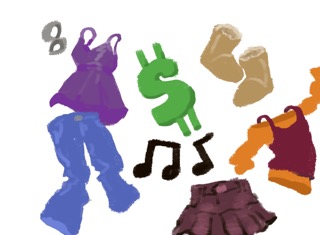Elizabeth Brady ’25 is a public policy major and an English minor, and she is a member of Alpha Chi Omega. She loves art, music and movies. Email her at eabrady@wm.edu.
The views expressed in this article are the author’s own.
For most people in the 18-22 age bracket, the 2008 financial recession was felt as a looming anxiety — a strange, foreign and very grown up-sounding background chorus of cable news headlines and suburbs full of “For Sale” signs. While foreclosure was less real to us than “Dragon Tales,” what we might actually remember is the music, fashion and culture of that era. Recession fashion is simple, a bit drab, focused on basics and functionality. Examples from the 2008 recession are Lanvin’s, Gucci’s and Versace’s 2008-2009 ready-to-wear collections. Silhouettes are trimmer, with sparser fabric and ornamentation… everything is just kind of less.
When we think about recession music, however, the trend is the opposite: recession-era club, house and pop music is more. Lady Gaga’s “Fame,” Rihanna’s “Good Girl Gone Bad,” Beyonce’s “I Am… Sasha Fierce,” Coldplay’s “Viva la Vida,” Pitbull, the Black-Eyed Peas, fast house music with shiny, heavy production.
There’s a certain look and feel to the recession, and for those of us for whom it was the setting of our childhood, it has a certain warm and fuzzy nostalgia to it.
Recently, trends in music and fashion have started to skew recession-y; fashion is getting smaller, and music is getting bigger. The Y2k/McBling craze is starting to wane, and as the pendulum swings the other way, runway fashion has started to pare down. 2024 collections from Gucci, Dior, Chanel and Lanvin all mirror trends from 2008-2009.
Music has also started to get bigger in the same ways it did from 2008 to 2012. Charli XCX’s world-alerting, club-shaking album “Brat” is a big album; it’s fast and catchy and debaucherous in ways that remind one of the pop girls of the 2010’s. Sabrina Carpenter’s new album “Taste” has the girlishness of Katy Perry’s “One of the Boys.” We are dancing like we have no money again.
But as young adults about to enter the workforce full-time, the idea of recession-core coming back is maybe more terrifying than it is nostalgic. If you’re reading any news ever, it does kind of seem like the economy is a car that is perpetually crashing. It may feel like another life-altering recession is licking at your heels, but the reality is not so dire.
There are a couple main markers that financial analysts use to determine the likelihood of economic recession. The Sahm Recession Indicator uses data about changes in unemployment rates to predict oncoming recession. According to current data, the Sahm Indicator does not demonstrate a high likelihood of recession anytime soon.
Analysts also use quarterly GDP to tell whether or not a recession is currently happening. The GDP recession index does not indicate a current recession.
So, if there is no actual recession, what’s the reason for the resurgence of recession-core fashion? Questions about why people wear and make things are nebulous, questions about why people like things even more so. However, there are two really compelling hypotheses out there right now.
The first is that the resurgence of recession-core is not the result of scarcity, but luxury. Stealth wealth, the idea that the truly wealthy 1% do not flaunt their wealth, but rather artfully conceal it in ways undetectable to those outside of that 1%, has become more popular in recent years. Shows like “Succession,” brands like The Row and celebrities like Gwyneth Paltrow are all examples of this muted, dog-whistling glamor. Some theorize that rather than financial hardships trickling up from the average consumer to fashion brands, stealth-wealth fashion is trickling down from rich people trying to hide their wealth to people who actually do not have any.
The second hypothesis is that due to an ever-tightening trend cycle, we are experiencing the same progression of trends, just out of pace with the real-world events that usually coincide with them. The influence of social media and fast fashion on what we choose to wear cannot be overstated; messaging about fashion is disseminated faster, and new items are available more immediately than ever before. Trends emerge, take over and die faster than they ever have before. The trend cycle is speeding up, while the economic cycle has not changed pace, putting them out of step with one another.
If the world is ending, it’s not because earth tones are back in style; it’s for one of the many other reasons that the world could be ending. Enjoy your good music and pencil skirts, it’s gonna be alright.

